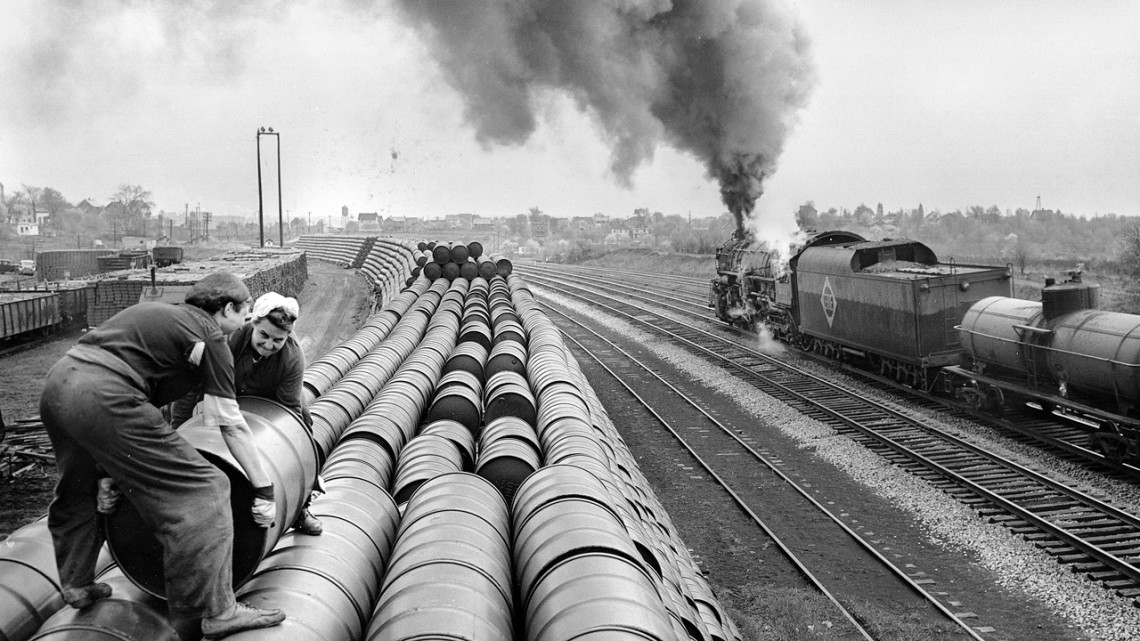
During World War II, women were encouraged to apply for railroad jobs. These “Rosies’” were often the wives of railroaders deployed overseas. This image shows two women in the freight and classification yard of the Erie Railroad.
Exhibit sheds light on railways’ discriminatory history
By Jose Beduya
The American rail system has connected people and places across the nation, but its early history is marked by division and violence.
A new exhibit at Cornell University Library’s Catherwood Library in the ILR School, “The Other Side of the Tracks: Discrimination and Social Mobility in the Railroad Industry,” exposes the plight of marginalized African American and women railroad workers during the first half of the 20th century.
The railways were very dangerous places to work, said curators Elizabeth Parker and Steven Calco, who gathered historical photographs, documents and objects from the extensive railroad collections of the Kheel Center for Labor-Management Documentation and Archives.
A claims ledger from the early 1900s, for example, lists all manner of death and loss of limb from accidents on the tracks.
“Every page you look at is more alarming than the last,” said Calco, research archivist at the Kheel Center. “A column would say how much the victims or their families were paid, and most of the time that was blank.”
Black train employees also faced insidious threats from their white counterparts, including a wave of assassinations in the Memphis District of the Illinois Central Railroad from the 1910s to the 1940s.
“African American trainmen and brakemen were getting shot off the backs of trains by their white co-workers, and the perpetrators were never brought to justice,” said Parker, technical services archivist and railroad collections archivist at the Kheel Center.
“We honor all the victims during this time period,” Parker said, “by listing their names and describing what happened to them, where they worked and when they passed away.”
Inequities in wages, lack of opportunities, and gender and racial discrimination were rampant in the railroad industry. The first labor groups and unions sprung from these harsh conditions, including the all-black Brotherhood of Sleeping Car Porters (BSCP) founded in 1925 by civil rights leader Asa Philip Randolph. Nearly four decades later, Randolph helped organize the 1963 March on Washington for Jobs and Freedom, where Martin Luther King Jr. delivered his “I have a dream” speech.
BSCP slogans and images on display convey strength and resistance. In one illustration for the Brotherhood’s 12th anniversary, for example, a black porter is rendered as a giant hoisting the BSCP banner on top of the world. These representations were in stark contrast to images of the ever-smiling subservient worker portrayed in the publications of railway giants like the Pullman Company, known for opulent train cars and infamous for exploitative practices.
“The Pullman Company was notoriously anti-union,” Calco said, “but, as the largest employer of African Americans in the United States in the 1920s and 1930s, it also provided opportunities for social mobility within the industry.”
Alongside the brotherhoods, women also formed groups known as “auxiliaries” to help with organizing, fundraising and recruiting. Women leaders are featured prominently in the exhibit, including portraits of the presidents of the Grand Lodge of the Ladies Society of the Brotherhood of Locomotive Firemen and Enginemen.
During World War II, with a shortage of workers, women found jobs previously reserved for men. On display are pictures of women welding railway parts, cleaning engines and moving barrels against the backdrop of an industry, and a society, in flux.
“With these gems from the archives, we try to bring untold stories to light of people who are misrepresented or underrepresented within the historical record,” Calco said.
The stories of African American and women railroad workers reveal as much about the present as they do the past, Parker said.
“Activism and the struggle for equality in the workplace very much mirror the continuing broader struggle for equality in society,” she said.
“The Other Side of the Tracks” runs through Aug. 31. Avi Bhavnesh Gandhi, MRP ’19; Jennifer Elizabeth King ’20; Brandon Hoak ’21; and Alessandro Powell, MILR ’20, assisted in the exhibit.
Jose Beduya is a staff writer, editor and social media coordinator for Cornell University Library.
Media Contact
Get Cornell news delivered right to your inbox.
Subscribe